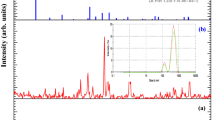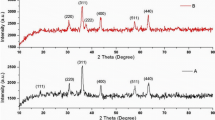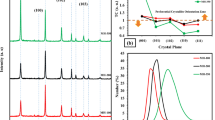Abstract
In the present work, characterization of water soluble colloidal MnO2 nanoflakes which act as an oxidizing agent was carried out using UV–visible spectroscopy. Transmission electron microscopy microstructure of colloidal MnO2 nanoflakes confirms the shape and nature of these particles. Selected area electron diffraction ring indicated that colloidal nanoflakes were amorphous in nature. Surface morphology of synthesized colloidal MnO2 nanostructure was determined by field emission scanning electron microscopy indicating a crumpled net like arrangement.
Similar content being viewed by others
Avoid common mistakes on your manuscript.
1 Introduction
Transition nonmetal oxides have attracted the attention of chemists and environmentalists due to their broad application in various areas such as antimicrobial activity [1], water treatment [2], food packaging [3], medical devices [4], textile industries [5, 6] and antibacterial activities [7,8,9]. Manganese dioxide nanostructure materials exhibit novel physical and chemical properties and are widely used in biomedical field as bactericide [10,11,12,13] and applied as a coat onto an ultrafiltration membrane to destroy toxins present in drinking water [14, 15]. The performance of nanostructure materials is greatly affected by their morphologies and crystallographic forms. A variety of methods like sol–gel, hydrothermal, electro deposition, combustion, and micro emulsion are applied to synthesize different morphology nanowires, nanoplates, and nanoparticles [16,17,18,19,20].
Water soluble nanoparticles of MnO2 are good substitute over the insoluble forms due to increased catalytic and oxidizing activities. The adsorption properties of MnO2 makes it an appropriate choice as a catalyst for redox reactions. Oxidation of formic and oxalic acid in aqueous medium [21, 22], and in micellar medium [23] are noteworthy. Our group is currently engaged in oxidation reactions using water soluble nanoparticles of colloidal MnO2 in both micellar and aqueous media [24,25,26,27,28,29] not only because of its broad usage in catalysis, ion-exchange, molecular adsorption, biosensor but also due to its low economical price and eco-friendliness. Solution based base synthesis and use of metal oxide nanostructures is popular due to economically cheap, mild, and viable conditions. It occurs under environmentally safe settings without additional templates and sophisticated apparatus. Synthesis of nanomaterial in the form of colloidal solution provides the possibility of separate nucleation avoiding inter-particle aggregation and controlled growth.
In this paper, we report the characterization, surface morphology and microstructure of water soluble MnO2 nanoflakes which has not been reported so far in literature.
2 Experimental
2.1 Materials
KMnO4 (E. Merck, India, 98.5%) and Na2S2O3 (s. d. fine, India, 99%) were commercial products and were used as supplied. Deionized water was used as the solvent after double distillation.
2.2 Preparation of water-soluble manganese dioxide nano flakes
Manganese dioxide nano flakes were prepared in aqueous medium using potassium permanganate and sodium thiosulfate as precursors. Standardized KMnO4 (0.1 M) and sodium thiosulfate (0.1 M) were used as stock solutions. To a one-liter volumetric flask filled with 3/4 portions of deionized water, 8 mL KMnO4 stock solution was added. 3 mL stock sodium thiosulfate solution was added to the volumetric flask containing homogeneous KMnO4 solution followed by gentle shaking then its concentration becomes 8 × 10–4 mol dm-3 (stock solution of Colloidal MnO2). The volumetric flask was made up to the mark with deionized water. The resulting solution is a dark brown colloidal system.
3 Results and discussion
3.1 Characterization of water soluble MnO 2 nanoflakes
The MnO2 nanoflakes in colloidal form were characterized by UV–visible spectroscopy scanning from wavelength 200 to 600 nm [2, 4, 10]. Surface morphology of synthesized MnO2 was determined by field emission scanning electron microscopy (FESEM) (Zeiss SUPRA 40 field emission electron microscope). A small amount of colloidal solution drops casted on a clean aluminum foil and dried at 50 °C to remove the solvent (water). Thin film of MnO2 formed on aluminum foil coated with gold and used for FESEM analysis. Microstructures of nanoflakes were determined by transmission electron microscopy (TEM) analysis (Tecnai FEI G2 transmission electron microscope operated at 200 kV). Select area electron diffraction (SAED) was taken on the nanoflakes during the TEM analysis. Samples for TEM measurement was prepared by placing a drop of MnO2 sol on a holey carbon-coated standard copper grid (300 mesh).
3.2 Surface morphology and microstructure
Field emission scanning electron microscopy image of colloidal MnO2 was taken in a Ziss Supra 40 FESEM operated under 5 kV accelerating voltage. The colloidal solution of MnO2 was drop casted on a carbon tape and dried at 60 °C for 6 h. Further, the sample deposited carbon tape was mounted on the sample holder of FESEM and coated with a thin film of gold. TEM image was captured in a FEI Techni G2 TEM operated at 200 kV accelerating voltage. The colloidal solution was drop casted on a carbon coated Cu TEM grid and allowed to stand at room temperature for overnight. Finally, the grid was used for TEM study.
Surface morphology of synthesized colloidal MnO2 nanostructure was determined by FESEM analysis as shown in Fig. 1. Low magnification micrograph showed aggregated nano structures with a net like morphology.
Magnified image clearly revealed that netlike aggregates were composed with very thin flakes of MnO2. Thickness of each flake was found to be about 2–4 nm. TEM was used to analyze the morphology and particle size of colloidal nanoflakes as shown in Fig. 2.
The image shows that nanoflakes are found in aggregates and are stacked one over the other, crumpled and assembled to form net like arrangement. Selected area electron diffraction (SAED image 2 (Fig. 2) reveals a diffused ring pattern. This diffused SEAD ring indicated that colloidal nanoflakes were amorphous in nature. Elemental analysis was done with the help of energy dispersive X-ray (EDX).
Figure 3 shows the constituent element of colloidal nanostructures. Presence of manganese and oxygen confirms the formation of manganese dioxide which was further supported by UV–VIS spectra of colloidal MnO2 [24,25,26,27,28,29,30]. The UV–visible spectra of water soluble colloidal MnO2 nanoflakes showed λmax at 390 nm. For this wavelength (λmax) Kabir Ud-Din et al. [24,25,26,27,28] and Kabir Ud-Din and Iqubal [29, 30] had worked and suitable for kinetic observations.
4 Conclusion
In summary, the author has successfully reported the surface morphology and microstructure of water soluble colloidal MnO2 nanoflakes. TEM microstructure of colloidal MnO2 nanoflakes confirm that the particles are spherical and amorphous in nature. It is conducted with economically cheap and readily available reagents. The reaction occurs under mild and under environmentally safe conditions. Thus, it is believed that the present work is a major breakthrough in the area of nanomaterials.
Data availability statement
Data will be made available upon request.
Change history
02 November 2022
A Correction to this paper has been published: https://doi.org/10.1007/s43994-022-00011-8
References
Alimohammadi F, Sharifian Gh M, Attanayake HK, Thenuwara AC, Gogotsi Y, Anasori B, Strongin DR (2018) Antimicrobial properties of 2D MnO2 and MoS2 nanomaterials vertically aligned on graphene materials and Ti3C2 MXene. Langmuir 34(24):7192–7200. https://doi.org/10.1021/acs.langmuir.8b00262
Qilin Li, Mahendra S, Lyon DY, Brunet L, Liga MV, Dong Li, Alvarez PJJ (2008) Antimicrobial nanomaterials for water disinfection and microbial control: potential applications and implications. Water Res 42:4591–4602. https://doi.org/10.1016/j.watres.2008.08.015
Duncan TV (2011) Applications of nanotechnology in food packaging and food safety: Barrier materials, antimicrobials and sensors. J Colloid Interface Sci 363(1):1–24. https://doi.org/10.1016/j.jcis.2011.07.017
Singh M, Singh S, Prasad S, Gambhir IS (2008) Nanotechnology in medicine and antibacterial effect of silver nanoparticles. Dig J Nanomater Biostruct 3(3):115–122
Dastjerdi R, Montazer MA (2010) A review on the application of inorganic nano-structured materials in the modification of textiles: focus on anti-microbial properties. Colloids Surf B Biointerfaces 79(1):5–18. https://doi.org/10.1016/j.colsurfb.2010.03.029
Montazer M, Alimohammadi F, Shamei A, Rahimi MK (2012) In situ synthesis of nano silver on cotton using Tollens’ reagent. Carbohydr Polym 87(2):1706–1712. https://doi.org/10.1016/j.carbpol.2011.09.079
Zou X, Zhang L, Wang Z, Luo Y (2016) Mechanisms of the antimicrobial activities of graphene materials. J Am Chem Soc 138(7):2064–2077. https://doi.org/10.1021/jacs.5b11411
Liu S, Zeng TH, Hofmann M, Burcombe E, Wei J, Jiang R, Kong J, Chen Y (2011) Antibacterial activity of graphite, graphite oxide, graphene oxide, and reduced graphene oxide: membrane and oxidative stress. ACS Nano 5(9):6971–6980. https://doi.org/10.1021/nn202451x
Pham VTH, Truong VK, Quinn MDJ, Notley SM, Guo Y, Baulin VA, Al Kobaisi M, Crawford RJ, Ivanova EP (2015) Graphene induces formation of pores that kill spherical and rod-shaped bacteria. ACS Nano 9(8):8458–8467. https://doi.org/10.1021/acsnano.5b03368
MuhamedHaneefa M, Jayandran M, Balasubramanian V (2017) Evaluation of antimicrobial activity of greensynthesized manganese oxide nanoparticles and comparative studies with curcuminaniline functionalized nanoform. Asian J Pharm Clin Res 10(3):347–352. https://doi.org/10.22159/ajpcr.2017.v10i3.16246
Sivaraj D, Vijayalakshmi K (2017) Preferential killing of bacterial cells by hybrid carbon nanotube MnO2 nanocomposite synthesized by novel microwave assisted processing. Mater Sci Eng C 81:469–477. https://doi.org/10.1016/j.msec.2017.08.027
Krishnaraj C, Ji BJ, Harper SL, Yun SI (2016) Plant extract-mediated biogenic synthesis of silver, manganese dioxide, silver-doped manganese dioxide nanoparticles and their antibacterial activity against food- and water-borne pathogens. Bioprocess Biosyst Eng 39(5):759–772. https://doi.org/10.1007/s00449-016-1556-2
Yu W, Brown M, Graham NJD (2016) Prevention of PVDF ultrafiltration membrane fouling by coating MnO2 nanoparticles with ozonation. Sci Rep 6:1–12. https://doi.org/10.1038/srep30144
Rutz A (2009) Synthesis and properties of manganese oxide nanoparticles for environmental applications. NNIN REU research accomplishments 98–99
Li Y, Weia D, Du Y (2015) Oxidative transformation of levofloxacin by δ-MnO2: products, pathways and toxicity assessment. Chemosphere 119:282–288. https://doi.org/10.1016/j.chemosphere.2014.06.064
Muddapur UM, Lava MB, Mahnashi MH, Alshahrani MA, Asiri M, Basavegowda N, Yaraguppi D, Bagewadi ZK, Khan AA, Iqubal SMS, Shaikh IA, Mannasaheb BA (2022) Evaluation of green synthesized gold nanoparticles from abrus precatorius seeds for their antibacterial, anti-inflammatory, anti-proliferative and antidiabetic properties. Lat Am J Pharm 41(2):420–427
Muddapur UM, Alshehri S, Ghoneim MM, Mahnashi MH, Alshahrani MA, Khan AA, Iqubal SMS, Bahafi A, More SS, Shaikh IA, Mannasaheb BA, Othman N, Maqbul MS, Ahmad MZ (2022) Plant-based synthesis of gold nanoparticles and theranostic applications: a review. Molecules 27(4):1391. https://doi.org/10.3390/molecules27041391
Shaikh IA, Muddapur UM, Bagewadi ZK, Chiniwal S, Ghoneim MM, Mahnashi MH, Al-Saikhan FI, Yaraguppi D, Niyonzima F, More SS, Mannasaheb BA, Al Ali A, Asiri A, Khan AA, Iqubal SMS (2022) Characterization of bioactive compounds from Accacia concinna and Citrus lemon, silver nanoparticles production of A. concinna extract and their biological properties. Molecules 27(9):2715. https://doi.org/10.3390/molecules27092715
Iqbal N, Iqubal SMS, Khan AA, Mohammed T, Alshabi AM, Aazam ES, Rafiquee MZA (2021) Effect of CTABr (surfactant) on the kinetics of formation of silver nanoparticles by Amla extract. J Mol Liq 329:115537. https://doi.org/10.1016/j.molliq.2021.115537
Al Awadh AA, Shet AR, Patil LR, Shaikh IA, Alshahrani MM, Nadaf R, Mahnashi MH, Desai SV, Muddapur UM, Achappa S, Hombalimath VS, Khan AA, Gouse HSM, Iqubal SMS, Kumar V (2022) Sustainable synthesis and characterization of zinc oxide nanoparticles using Raphanus sativus extract and its biomedical applications. Crystals 12(8):1142. https://doi.org/10.3390/cryst12081142
Perez-Benito JF, Arias C (1992) A kinetic study of the reaction between soluble (colloidal) manganese dioxide and formic acid. J Colloid Interface Sci 149:92–97. https://doi.org/10.1016/0021-9797(92)90394-2
Perez-Benito JF, Arias C, Amat E (1996) A kinetic study of the reduction of colloidal manganese dioxide by oxalic acid. J Colloid Interface Sci 177(2):288–297. https://doi.org/10.1006/jcis.1996.0034
Tuncay M, Yuce N, Arlkan B, Gokturk S (1999) A kinetic study of the reaction between colloidal manganese dioxide and formic acid in aqueous perchloric acid solution in the presence of surface active agents. Colloids Surf A Physicochem Eng Asp 149:279–284. https://doi.org/10.1016/S0927-7757(98)00520-2
Kabir-ud-Din, Fatma W, Khan Z (2004) Effect of surfactants on the oxidation of oxalic acid by soluble colloidal MnO2. Colloids Surf A Physicochem Eng Asp 234:159–164. https://doi.org/10.1016/j.colsurfa.2003.12.015
Kabir-ud-Din, Iqubal SMS, Khan Z (2005) Kinetics of the reduction of colloidal MnO2 by citric acid in the absence and presence of ionic and non-ionic surfactants. Inorg React Mech 5:151–166. https://doi.org/10.1515/IRM.2005.5.3.151
Kabir-ud-Din, Iqubal SMS, Khan Z (2005) Oxidation of dl-tartaric acid by water soluble colloidal MnO2 in the absence and presence of surfactants. Indian J Chem 44A:2455–2461. http://hdl.handle.net/123456789/20242
Kabir-ud-Din, Iqubal SMS, Khan Z (2005) Reduction of soluble colloidal MnO2 by dl-malic acid in the absence and presence of nonionic Triton X-100. Colloid Polym Sci 283:504–511. https://doi.org/10.1007/s00396-004-1215-z
Kabir-ud-Din, Iqubal SMS, Khan Z (2005) Effect of ionic and non-ionic surfactants on the reduction of water soluble colloidal MnO2 by glycolic acid. Colloid Polym Sci 284:276–283. https://doi.org/10.1007/s00396-005-1373-7
Kabir-ud-Din, Iqubal SMS (2010) Kinetics of the reduction of water soluble colloidal MnO2 by mandelic acid in the absence and presence of non-ionic surfactant Triton X-100. Colloid J 72:195–204. https://doi.org/10.1134/S1061933X1002008
Kabir-ud-Din, Iqubal SMS (2009) Nanosized MnO2: preparation, characterization and its redox activity. Int J nanoparticles 2:342. https://doi.org/10.1504/IJNP.2009.028766
Acknowledgements
The author is thankful to Dean (Ibn Sina National College for Medical Studies, Jeddah, Saudi Arabia- Dr. Rashad Al Kashgari), Chairman (Department of General Science- Dr. Tasneem Mohammed) and Dr. Aejaz A. Khan (Faculty of General Science, Chemistry Section) Ibn Sina National College for Medical Studies, Jeddah, Kingdom of Saudi Arabia for their constant support and encouragement for this work.
Funding
No sources of financial funding and support.
Author information
Authors and Affiliations
Corresponding author
Ethics declarations
Conflict of interest
No conflict of interest.
Additional information
Publisher's Note
Springer Nature remains neutral with regard to jurisdictional claims in published maps and institutional affiliations.
Rights and permissions
Open Access This article is licensed under a Creative Commons Attribution 4.0 International License, which permits use, sharing, adaptation, distribution and reproduction in any medium or format, as long as you give appropriate credit to the original author(s) and the source, provide a link to the Creative Commons licence, and indicate if changes were made. The images or other third party material in this article are included in the article's Creative Commons licence, unless indicated otherwise in a credit line to the material. If material is not included in the article's Creative Commons licence and your intended use is not permitted by statutory regulation or exceeds the permitted use, you will need to obtain permission directly from the copyright holder. To view a copy of this licence, visit http://creativecommons.org/licenses/by/4.0/.
About this article
Cite this article
Iqubal, S.M.S. Characterization, surface morphology and microstructure of water soluble colloidal MnO2 nanoflakes. J.Umm Al-Qura Univ. Appll. Sci. 8, 33–36 (2022). https://doi.org/10.1007/s43994-022-00007-4
Received:
Accepted:
Published:
Issue Date:
DOI: https://doi.org/10.1007/s43994-022-00007-4







